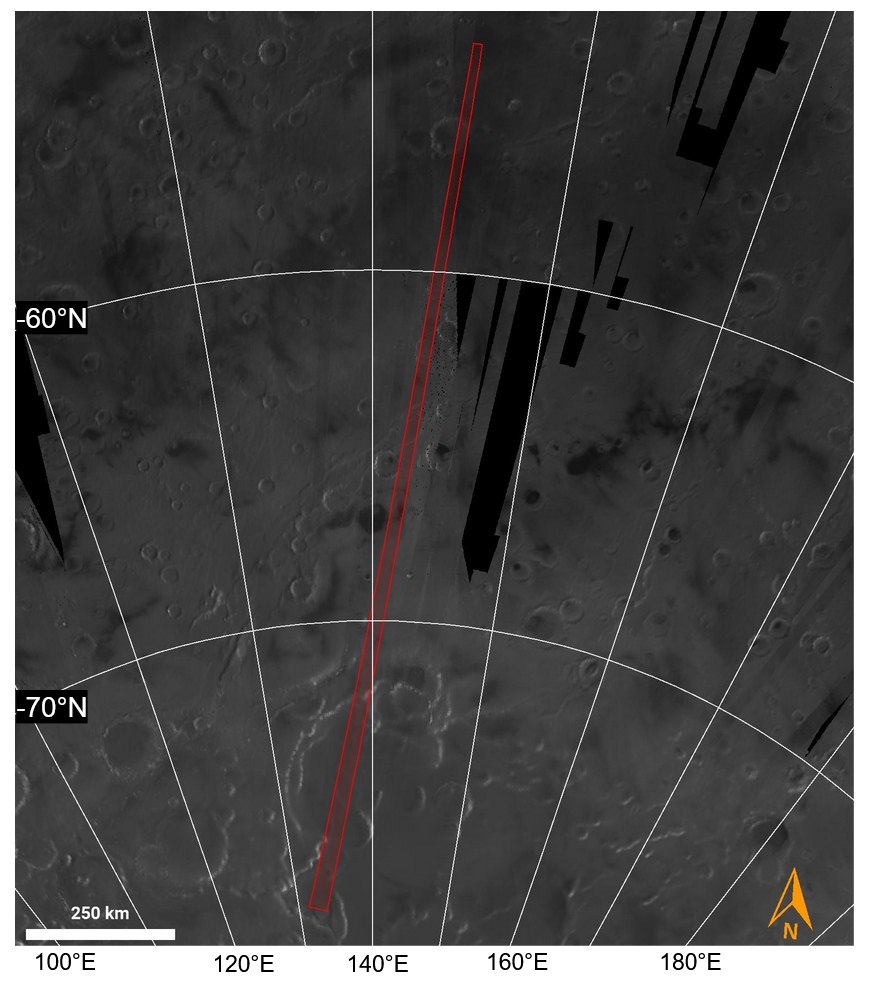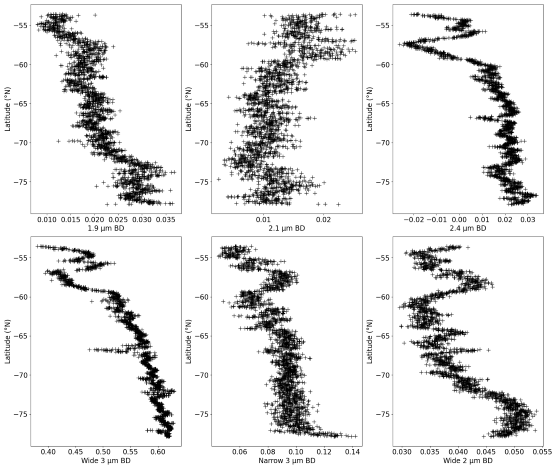Spectral variability of the south polar region of Mars and implications for hydration and sulfate mineralogy
- 1Institut d’Astrophysique Spatiale, CNRS, Université Paris-Saclay, 91400 Orsay, France (oceane.barraud@ias.u-psud.fr)
- 2Dept. of Astronomy and Planetary Science, Northern Arizona University, Flagstaff, AZ 86001, USA
Introduction
Observations from OMEGA, the visible-near infrared hyperspectral imager onboard the Mars Express orbiter, highlighted spectral variability of the Martian high latitude surfaces [1]. In particular, the 1.9 µm and 3 µm band depths increase from 60° latitudes towards the poles [1, 2, 3], which suggests that hydrated minerals may participate in this spectral variability. [3] reported the detection of a deep and relatively narrow absorption band at 3 µm coupled with a shallow but significantly wider 4 µm feature in the northern high latitudes of Mars, with no significant counterpart in the south for now. Comparison with laboratory spectra suggest that these features may be associated with the presence of salts such as sulfates and/or perchlorates [3]. In the south polar region, several absorption features related to water-bearing minerals (e.g., sulfates, phyllosilicates) have been identified in the 1 – 2.6 µm spectral range [1, 4]. As a result, sulfate salts were mapped over large areas there, but their precise mineralogy and distribution is not constrained [4]. Moreover, the 1.9 µm band is significantly broader and shifts to slightly longer wavelengths in the south which seems to indicate a specific mineralogy, and/or a different hydration state from that of the north [1]. Here we present the preliminary results of a study about the combined evolution of the spectral features identified in the southern high latitudes.
Method
The OMEGA (Observatoire pour la Minéralogie, l’Eau, les Glaces, et l’Activité) instrument has been observing the surface of Mars since 2004 between 0.35 and 5.1 µm. Here, we selected observations acquired during southern spring and summer as high latitudes are covered by seasonal ice during winter. Our analyses focus on the detection and characterization of hydrated minerals, in particular sulfates, using several spectral criteria previously defined: the band depths at 1.9 µm [5], 2.1 µm [6] and 2.4 µm [3]; the narrow [3] and wide 3 µm band depths [2]. We have also developed a new estimator for the wide band depth observed around 2 µm in the south polar region [1]:
where is the average reflectance from the n spectels corresponding to wavelengths (µm). Since the 3 µm band is very sensitive to the presence of water ice at the surface or in the atmosphere [7], we remove pixels with a water ice absorption at 1.5 µm>1%. In order to prevent possible effects related to viewing geometry, we removed pixels with emergence and incidence angles respectively higher than 10° and 75°.
Preliminary results
The parameters exhibit a strong variability in the south polar region (Figure 1 and 3) which suggest possible variations of the hydration state and/or mineralogical composition of the surface. As already demonstrated, the 1.9 µm and the wide 3 µm band depths increase towards the pole (Figure 2 and 3). The intensity of the “narrow 3 µm band” criteria such as defined by [3] is significantly (two times) lower than in the north polar region. The wide band depth around 2 µm is higher than 3% in the whole area and increases up to 5% at 75°S. Beside this regional spectral variability, we can also notice localized area which may have a specific spectral pattern, e.g., near 58°S where the 3 µm band shape is modified in such a way that the wide band depth criteria is reduced while the narrow one increases; at the same time the 2.4 µm band is reduced while the wide 2 µm criteria increases (Figure 2 and 3). Although not following as clear a latitudinal trend, we find large areas of hydrated sulfate salt signatures through a combination of the 1.9 µm band and 2.4-2.5 µm spectral shoulder. These occur preferentially at high southern latitudes.
Perspectives
Preliminary results show a large range of diversity in the near-infrared between 1.4 and 2.6 µm but also around 3 µm (Figure 1). The band depths at 1.9 and 3 µm are strong indicators of the surface hydratation [2] and bands in the 1.9 - 2.1 and 2.4 µm ranges may be associated with sulfates [4, 8]. By using these band depths and additional spectral criteria, we plan to estimate the coverage and properties of hydrated minerals, in particular sulfates, in the south polar region, following previous studies by [1] and [4]. We also plan independent validation and further characterization of the mineralogy of some of these areas using CRISM high-resolution observations. This reappraisal of available spectral constraints compared with the geomorphological context will improve our understanding of the formation scenarios of the hydrated minerals, in particular sulfates, in the south polar region of Mars.

Figure 1: NIR-1 µm Albedo map [9] of the region where the OMEGA cube ORB2209_3 is located (latitude ranges between -53°N to -78°N and longitude between 131°E to 145°E).

Figure 2: Latitudinal variations of the spectral parameters in the OMEGA cube ORB2209_3 (Figure 1).
Figure 3: Variability of the spectral parameters in the OMEGA cube ORB2209_3 between -53°N to -65°N, from left to right: band depth at 1.9 µm, narrow and wide band depth at 3 µm and 2 µm.
Data availability
The OMEGA/MEx data are freely available on the ESA PSA at https://archives.esac.esa.int/psa/#!Table%20View/OMEGA=instrument. This work uses the OMEGA-Py Python module, freely available on GitHub at https://github.com/AStcherbinine/omegapy.
References
[1] Poulet et al., GRL, 35(20) (2008). [2] Jouglet et al., JGR:Planets 112.E8 (2007). [3] Stcherbinine et al., Icarus, 369, 114627 (2021). [4] Carter et al., Sixth International Conference on Mars Polar Science and Exploration (Vol. 1926, p. 6063) (2016). [5] Langevin et al., Science, 307, 5715 (2005). [6] Viviano-Beck et al., JGR:Planets, 119(6), 1403-1431(2014). [7] Vincendon et al., JGR:Planets 116.E11 (2011). [8] Gendrin et al., Science, 307, 5715, 1587-1591 (2005). [9] Ody et al., JGR:Planets, 117(E11), (2012)
How to cite: Barraud, O., Carter, J., Vincendon, M., and Stcherbinine, A.: Spectral variability of the south polar region of Mars and implications for hydration and sulfate mineralogy, Europlanet Science Congress 2022, Granada, Spain, 18–23 Sep 2022, EPSC2022-847, https://doi.org/10.5194/epsc2022-847, 2022.

